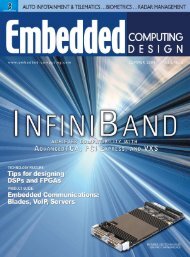CompactPCI and AdvancedTCA Systems - OpenSystems Media
CompactPCI and AdvancedTCA Systems - OpenSystems Media
CompactPCI and AdvancedTCA Systems - OpenSystems Media
You also want an ePaper? Increase the reach of your titles
YUMPU automatically turns print PDFs into web optimized ePapers that Google loves.
S P E C I A L<br />
E M I<br />
Active EMI power filter <strong>and</strong> hot swap<br />
functions merge<br />
By Bob Lanoue<br />
EMI control can be a complex design<br />
task that is dependent on many factors.<br />
However, a reduction of differential<strong>and</strong><br />
common-mode conducted noise<br />
created by the power converter(s) can<br />
be achieved by using either passive<br />
or active filters. In <strong>AdvancedTCA</strong> <strong>and</strong><br />
telecom systems, the redundancy requirement<br />
of field replaceable boards into<br />
functioning shelves drives the need<br />
for a current inrush limiting function<br />
on each board. This function is generally<br />
referred to as hot swap. This article<br />
focuses on the advantage of using<br />
certain core hot swap elements, for<br />
example, the FET, as the series element<br />
in the active differential filter <strong>and</strong> the<br />
current limit sense element for the filter<br />
control signal to achieve active EMI<br />
control. Using this approach, the<br />
designer gets added value: superior<br />
noise attenuation <strong>and</strong> additional<br />
savings in board space.<br />
Regulatory agencies, such as the FCC,<br />
require testing of complete OEM systems<br />
to certify that the noise emanating from<br />
the equipment falls below the st<strong>and</strong>ard<br />
maximum levels established for the category<br />
or class of equipment. In the case<br />
of power conversion solutions that use<br />
switching topologies, the benefits of high<br />
efficiencies <strong>and</strong> lower heat generation<br />
will be accompanied by increased electrical<br />
noise caused by high switching voltages<br />
<strong>and</strong> currents. The magnitude of the<br />
noise depends on several factors:<br />
■ Topology <strong>and</strong> components used<br />
■ Switching frequency<br />
■ PCB layout<br />
■ Magnitude <strong>and</strong> rate of change in the<br />
AC current <strong>and</strong> voltage levels<br />
Performance levels needed to meet<br />
these st<strong>and</strong>ards must be factored into the<br />
initial design phase of product development.<br />
Although some topologies are less<br />
noisy than others, most will fail at least<br />
the conducted emissions test<br />
at the expected power levels in<br />
<strong>AdvancedTCA</strong> boards without<br />
the proper design precautions.<br />
Active filter solutions can use<br />
less board space in comparison<br />
to a passive solution when<br />
the fundamental switching<br />
frequencies are at the low end<br />
of the conducted b<strong>and</strong> <strong>and</strong> the<br />
current levels are in the 3-15<br />
amp range.<br />
Generally, noise magnitudes <strong>and</strong> profiles<br />
of st<strong>and</strong>ard or embedded power converters<br />
are not readily available, so the ideal<br />
filter solution requires characterization<br />
testing to quantify the needs. St<strong>and</strong>ard<br />
brick filtering data is sometimes available<br />
with a recommended passive filter<br />
circuit using discrete components or<br />
a filter product. The physical size of<br />
those passive solutions versus available<br />
board area can become another issue.<br />
The <strong>AdvancedTCA</strong> PICMG 3.0 specification,<br />
section 4, defines the power distribution<br />
of up to 200 W per board with<br />
power conversion of the 48 V or 60 V<br />
input bus on each board within the shelf.<br />
Every board must be below the EN55022<br />
Class B level of the conducted noise limit.<br />
The specification allows up to 16 boards<br />
per shelf <strong>and</strong> requires a minimum 18 dB<br />
of additional shelf filtering over the conducted<br />
noise frequency range of 150 kHz<br />
to 30 MHz to assure the cumulative<br />
noise of a fully populated <strong>and</strong> functioning<br />
shelf stays below the compliance system<br />
noise limit.<br />
Figure 1<br />
Figure 1 shows a measurement plot for a<br />
st<strong>and</strong>ard converter using a spectrum analyzer<br />
with peak detection sampling <strong>and</strong> a<br />
special filter to separate the differential<br />
mode noise component. The pre-filtered<br />
(red trace) <strong>and</strong> post-filtered (blue trace)<br />
plots compared to the EN55022 Class B<br />
limit line illustrate the effects of the active<br />
differential filter circuit. This demonstrates<br />
the differential noise peak of the<br />
fundamental frequency <strong>and</strong> the harmonic<br />
peak amplitudes in dBuV units.<br />
Furthermore, to achieve high system<br />
reliability the PICMG 3.0 specification<br />
defines a redundant architecture for the<br />
power <strong>and</strong> communications/data processing<br />
bus. PICMG 3.0 specifies that a single<br />
board failure will not disrupt system operation.<br />
If a failure occurs, the faulty board<br />
can be readily identified <strong>and</strong> replaced<br />
in the field with the system operational.<br />
Insertion of the replacement board also<br />
cannot disrupt the power or communications/data<br />
processing buses; hence power<br />
management with hot board insertion<br />
<strong>and</strong> the Intelligent Platform Management<br />
Interface (IPMI) is needed to bring the<br />
replacement board up safely. And this circuitry<br />
must be replicated on each board.<br />
As suggested earlier, the hot swap function<br />
<strong>and</strong> differential noise attenuation<br />
can both be achieved, in effect, by using<br />
a combination of active filtering circuit<br />
<strong>and</strong> the power FET for the current limit<br />
control as shown in Figure 2. Along with<br />
the associated biasing components, U1 in<br />
the figure provides the current limit control,<br />
while U2 <strong>and</strong> U3 make up the active<br />
filter control. The compliance noise testing<br />
will be performed with the system<br />
or board in a typical operational or test<br />
mode. The current limit is exercised only<br />
under system start-up, board insertion, or<br />
18 / <strong>CompactPCI</strong> <strong>and</strong> <strong>AdvancedTCA</strong> <strong>Systems</strong> / September 2005

















